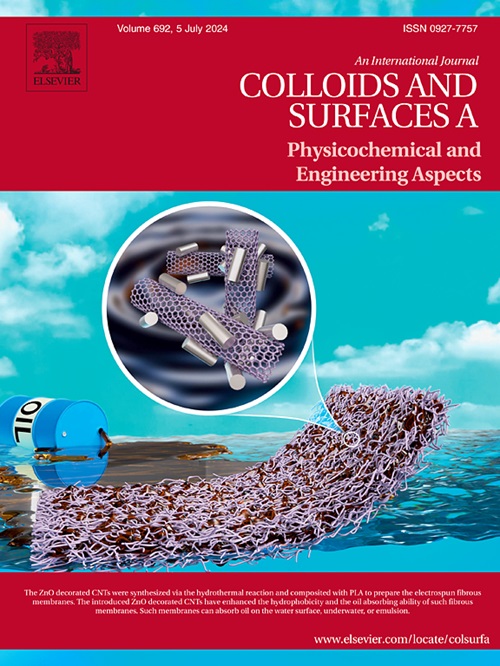Specific ion effects on the build-up and permeability of poly(diallyldimethylammonium) chloride/poly(sodium 4-styrenesulfonate) polyelectrolyte multilayers
IF 5.4
2区 化学
Q2 CHEMISTRY, PHYSICAL
Colloids and Surfaces A: Physicochemical and Engineering Aspects
Pub Date : 2025-07-05
DOI:10.1016/j.colsurfa.2025.137681
引用次数: 0
Abstract
Polyelectrolyte multilayers (PEMs) are very promising systems in the field of material science, intensively developed and broadly examined with constantly increasing interest in applications such as sensors, coatings, membranes, and biomedical interfaces. While the impact of ionic strength on PEM formation is well established, the influence of specific counterions remains underexplored. In this study, we systematically examine the effect of six monovalent cations—NH₄⁺, Li⁺, Na⁺, K⁺, Rb⁺, and Cs⁺—on the build-up, morphology, permeability, and surface wettability of PDADMAC/PSS multilayers assembled via the layer-by-layer technique. Using a combination of quartz crystal microbalance with dissipation (QCM-D), atomic force microscopy (AFM), cyclic voltammetry, and contact angle measurements, we demonstrate that the physicochemical properties of PEMs are strongly influenced by cation identity. Larger, chaotropic cations (Rb⁺, Cs⁺) produce thicker, smoother, and more compact films with reduced permeability, consistent with enhanced charge screening and interchain packing. In contrast, smaller, kosmotropic cations (Li⁺, Na⁺) lead to thinner, rougher, and more permeable films, suggesting weaker chain interactions and looser film structures. K⁺ induces exceptionally high surface hydrophobicity and blocking efficiency, while NH₄⁺ shows distinct behavior likely due to its hydrogen-bonding capabilities. A clear odd–even alternation in contact angle was observed, driven by the chemical nature of the terminating layer (PDADMAC vs. PSS), highlighting the importance of surface composition in wetting behavior. These findings demonstrate that even subtle differences in ion type can modulate film growth kinetics, surface morphology, and functional performance. The results offer new insights into the design of PEMs with tailored permeability, roughness, and surface energy, with direct implications for their optimization in electrochemical sensors, antifouling coatings, and controlled-release systems.
特定离子对聚(二烯基二甲基氯化铵)/聚(4-苯乙烯磺酸钠)聚电解质多层膜的形成和渗透性的影响
聚电解质多层膜(PEMs)是材料科学领域非常有前途的系统,在传感器、涂层、膜和生物医学界面等应用领域得到了广泛的开发和研究。虽然离子强度对PEM形成的影响已经确定,但特定反离子的影响仍未得到充分探讨。在这项研究中,我们系统地研究了六种一价阳离子- nh +、Li +、Na +、K +、Rb +和Cs +对通过层层技术组装的PDADMAC/PSS多层膜的构建、形态、渗透率和表面润湿性的影响。利用石英晶体耗散微天平(QCM-D)、原子力显微镜(AFM)、循环伏安法和接触角测量相结合的方法,我们证明了PEMs的物理化学性质受到阳离子身份的强烈影响。更大的、向乱性的阳离子(Rb +、Cs +)产生更厚、更光滑、更致密的膜,渗透率降低,与增强的电荷筛选和链间填充一致。相比之下,更小、亲宇宙的阳离子(Li +、Na +)可以生成更薄、更粗糙、更通透的薄膜,表明链相互作用更弱,薄膜结构更松散。K +诱导出异常高的表面疏水性和阻断效率,而NH +表现出不同的行为,可能是由于其氢键能力。在接触角上观察到明显的奇偶交替,这是由终止层的化学性质(PDADMAC vs. PSS)驱动的,突出了表面成分在润湿行为中的重要性。这些发现表明,即使离子类型的细微差异也可以调节膜的生长动力学,表面形态和功能性能。该结果为设计具有定制渗透率、粗糙度和表面能的PEMs提供了新的见解,对电化学传感器、防污涂层和控释系统的优化具有直接意义。
本文章由计算机程序翻译,如有差异,请以英文原文为准。
求助全文
约1分钟内获得全文
求助全文
来源期刊
CiteScore
8.70
自引率
9.60%
发文量
2421
审稿时长
56 days
期刊介绍:
Colloids and Surfaces A: Physicochemical and Engineering Aspects is an international journal devoted to the science underlying applications of colloids and interfacial phenomena.
The journal aims at publishing high quality research papers featuring new materials or new insights into the role of colloid and interface science in (for example) food, energy, minerals processing, pharmaceuticals or the environment.

 求助内容:
求助内容: 应助结果提醒方式:
应助结果提醒方式:


